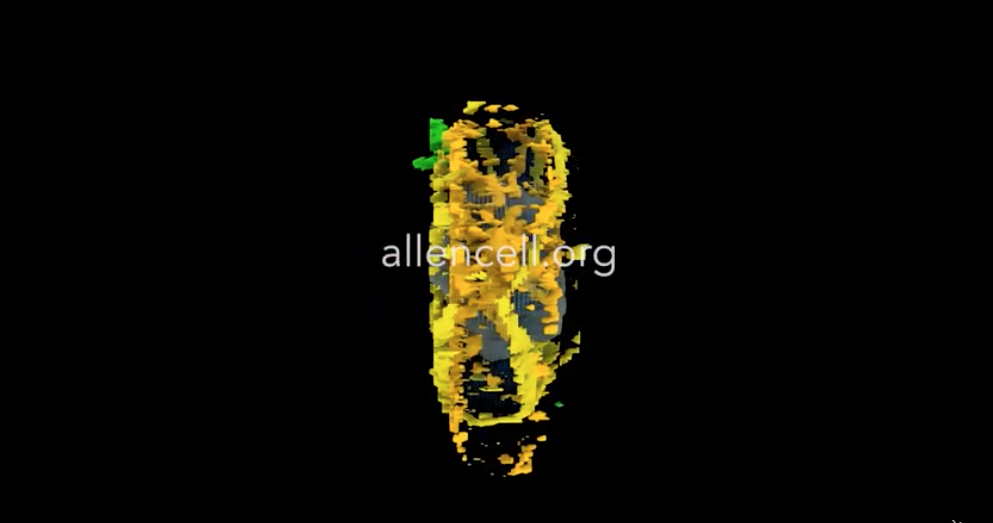This 3-D model of how cells divide may lead to breakthroughs in cancer research

Cell division is a process that scientists have been fascinated with since we first learned about cells. Through decades of study, scientists have come up with a basic narrative on how cells divide: Each phase of division, broadly called "mitosis," has been catalogued and analyzed up close. Now, the Allen Institute for Cell Science has come up with a better way to take a good look at the way all organisms form: a 3-D model that visualizes, in color-coded detail, the way a healthy human cell divides.
Announced in a press release on Wednesday, the Allen Institute's model of the Integrated Mitotic Stem Cell will enable "a deeper understanding" of the process of mitosis in human cells. In addition to helping us with "basic biology research," it will also be instrumental in cancer-related research.
Cancer is caused by the improper division and replication of cells — in the search for treatments and cures, scientists are often looking at why the specific cells that make up a cancerous growth are behaving that way. So having a full model of how a normal, healthy cell divides provides "a much-needed baseline" for comparison to cancerous cells, said Rick Horwitz, the executive director of the Allen Institute's Cell Science division.
The Week
Escape your echo chamber. Get the facts behind the news, plus analysis from multiple perspectives.

Sign up for The Week's Free Newsletters
From our morning news briefing to a weekly Good News Newsletter, get the best of The Week delivered directly to your inbox.
From our morning news briefing to a weekly Good News Newsletter, get the best of The Week delivered directly to your inbox.
Further studies into the mitosis process will be able to use the Allen Insitute's tool "to connect the dots between different parts of the cell," instead of studying just the chromosomes in isolation, said Tom Misteli, the director of the National Cancer Institute's Center for Cancer Research.
Take a look at the Integrated Mitotic Stem Cell here, or watch the Allen Institute's video about it below. Shivani Ishwar

A free daily email with the biggest news stories of the day – and the best features from TheWeek.com
Shivani is the editorial assistant at TheWeek.com and has previously written for StreetEasy and Mic.com. A graduate of the physics and journalism departments at NYU, Shivani currently lives in Brooklyn and spends free time cooking, watching TV, and taking too many selfies.
-
 A luxury walking tour in Western Australia
A luxury walking tour in Western AustraliaThe Week Recommends Walk through an ‘ancient forest’ and listen to the ‘gentle hushing’ of the upper canopy
-
 What Nick Fuentes and the Groypers want
What Nick Fuentes and the Groypers wantThe Explainer White supremacism has a new face in the US: a clean-cut 27-year-old with a vast social media following
-
 5 highly amusing cartoons about rising health insurance premiums
5 highly amusing cartoons about rising health insurance premiumsCartoon Artists take on the ACA, Christmas road hazards, and more
-
 Nobody seems surprised Wagner's Prigozhin died under suspicious circumstances
Nobody seems surprised Wagner's Prigozhin died under suspicious circumstancesSpeed Read
-
 Western mountain climbers allegedly left Pakistani porter to die on K2
Western mountain climbers allegedly left Pakistani porter to die on K2Speed Read
-
 'Circular saw blades' divide controversial Rio Grande buoys installed by Texas governor
'Circular saw blades' divide controversial Rio Grande buoys installed by Texas governorSpeed Read
-
 Los Angeles city workers stage 1-day walkout over labor conditions
Los Angeles city workers stage 1-day walkout over labor conditionsSpeed Read
-
 Mega Millions jackpot climbs to an estimated $1.55 billion
Mega Millions jackpot climbs to an estimated $1.55 billionSpeed Read
-
 Bangladesh dealing with worst dengue fever outbreak on record
Bangladesh dealing with worst dengue fever outbreak on recordSpeed Read
-
 Glacial outburst flooding in Juneau destroys homes
Glacial outburst flooding in Juneau destroys homesSpeed Read
-
 Scotland seeking 'monster hunters' to search for fabled Loch Ness creature
Scotland seeking 'monster hunters' to search for fabled Loch Ness creatureSpeed Read